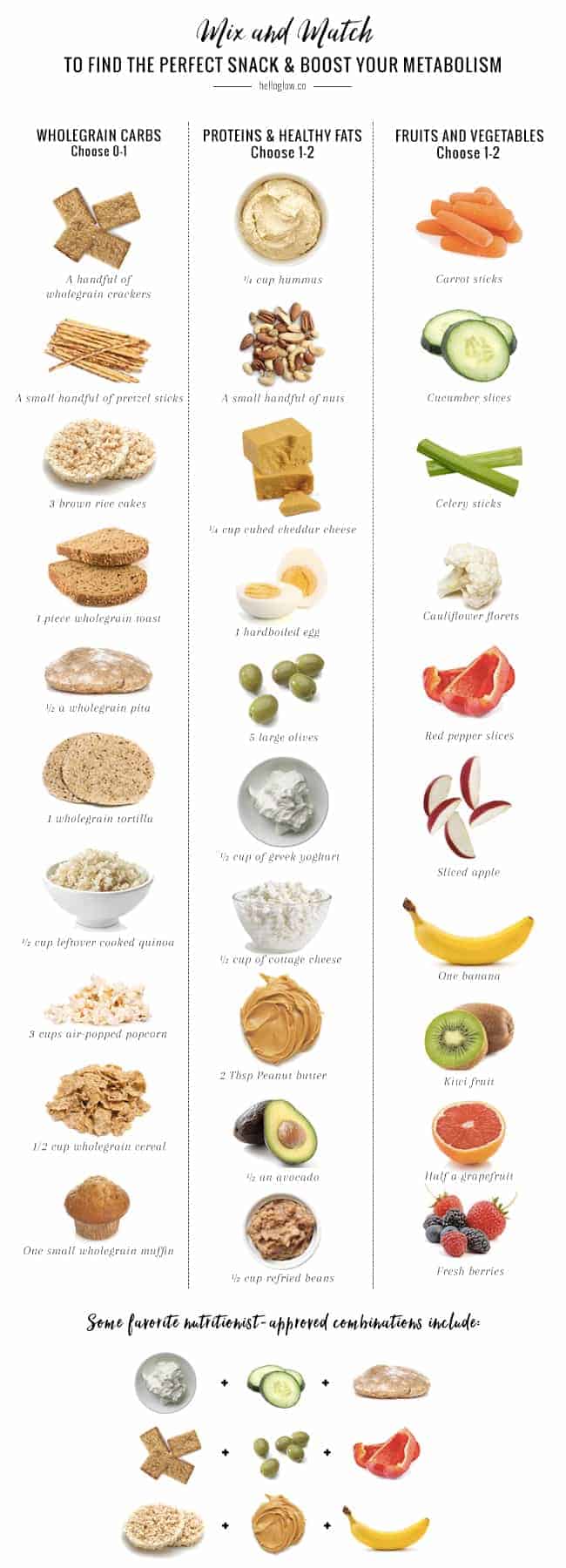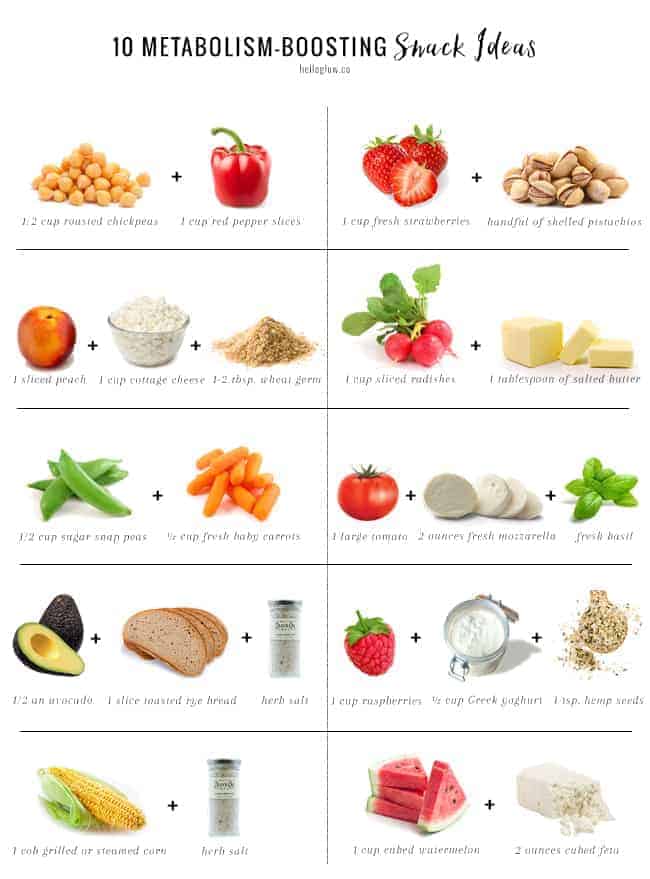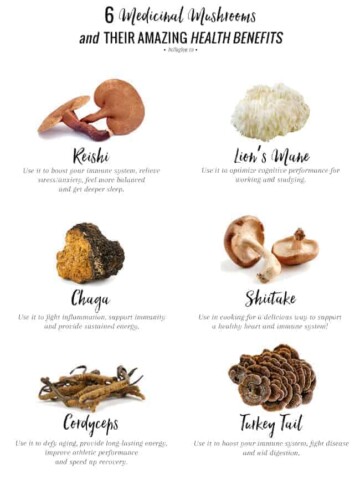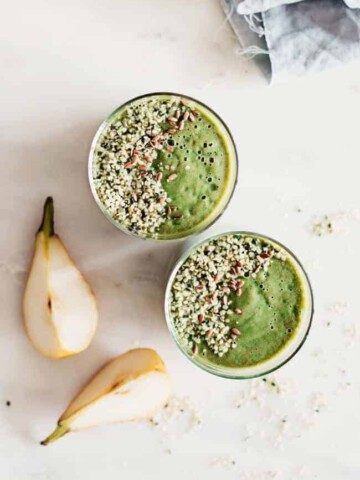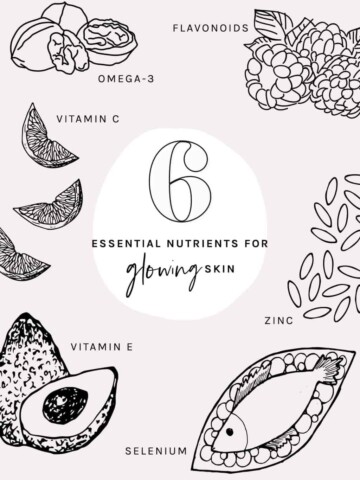According to recent research, snacking has really increased over the past 30 years [source]. Around 50% of all eating occasions in the U.S. are snacks [source], which accounts for about one-third of all adult calorie consumption. That’s a lot of snacks!
What constitutes a “good” snack is really up to you, but a definition I like to work with is a small amount of food eaten between meals. It should bridge the gap between full meals, fuel activities, and provide small bursts of energy.
Snacks to Boost Your Energy Metabolism

Produce + Protein
When people ask me about healthy snacking, I always say a great goal to have in mind is produce + protein or healthy fats. The combination of produce and protein or fat tends to be satiating since the food will move through your digestive system at a moderate pace while keeping blood sugar levels stable.
Research studies have shown that protein, fiber, and whole grains are the most filling snack foods [source]. Healthy fats can be a balancing energy source; for example, almonds were shown in one study to regulate blood sugar levels later [source].
Reaching for a sugary snack or simple carbs, on the other hand, can cause your blood sugar to spike then crash, which will wreak havoc on both your appetite and your energy levels.
Keep it snack-sized
When reaching for a snack, be mindful that the purpose of the snack is to bridge to your next meal, not become a meal itself. While our bodies need fuel, we also benefit from giving ourselves a break from constant digestion.
With this in mind, when you’re choosing snacks, go for snack-sized portions that will fill the hunger gap, yet ensure you’ll still be hungry when the time comes for your next meal.
Pre-portion
So many snacking occasions happen when we’re pressed for time, tired, and hungry, and we have a difficult time controlling both the type of snack (give me sugar!) and the portion size (ALL the sugar!).
One of the ways I work around this is to pre-portion snack foods into individual servings. For example, if you buy a big bag of nuts or are bulk shopping, take some time to pre-portion your snacks into single snack-sized servings in small jars or baggies.
Snack mindfully
Before you grab a snack, stop and ask yourself why you’re reaching for it in the first place [source]. Are you actually hungry? Or are you tired? Bored? Lonely? Sad? Having a craving?
I know I snack a lot at work when I'm really just looking for an excuse to get up from my desk. If the answer is anything other than true hunger, try replacing the snack with something else, like a quick walk around the block, some simple stretches, or a nice cup of tea.
If you’ve done those things and you still feel the need for a snack, then have one.
Fuel your day
If you're grabbing a snack between the office and your workout class, it should follow a different set of parameters than simply bridging the hunger gap between meals. For example, to get me through from lunch all the way to a late dinner and fuel an after-work swim, I often choose a much more energy-dense snack than I would otherwise.
On the other hand, if I know I'm going straight home to dinner, I choose a lighter snack, so I'll still end up hungry for my evening meal.
Use a system
Here’s a system I like to use when choosing my snacks: choose one snack-sized portion of a healthy whole-grain carb, one to two snack-sized portions of proteins and healthy fats, and one to two servings of veggies or fruit (this post details what a serving of produce looks like).
You can skip the wholegrain carbs if you’re not in the mood or if you’re not fueling a workout with your snack and simply stick to protein + produce.
Metabolism Boosting Snack Ideas for Summer
Combine Produce + Protein in Snacks
When choosing healthy snacks, I like to aim for a combination of produce and protein. Here’s why:
Protein is satiating. It sticks to your ribs and keeps you satisfied in a way that you wouldn’t be if you snacked solely on simple carbohydrates like crackers.
Protein helps keep blood sugar stable by slowing digestion and moderating the uptake of sugars into the bloodstream.
Produce is packed with nutritious vitamins, minerals, and antioxidants.
The dietary fiber in fresh fruits and vegetables also helps to keep blood sugar stable, similarly to protein.
Remember when you’re choosing snacks to go for one to two snack-sized portions of proteins and healthy fats, one to two servings of veggies or fruit, and if needed, one snack-sized portion of a healthy wholegrain carb.
Summer snack ideas
We’re heading into the best produce season of the year! So here’s a list of 10 metabolism-boosting snack ideas that celebrate spring and summer produce. All of these snack suggestions are around 100 calories, give or take.
—½ cup roasted chickpeas with 1 cup red pepper slices
—1 cup sliced fresh strawberries with a small handful of shelled pistachios
—Metabolism-boost fruit toast combos
—1 sliced peach with 1 cup cottage cheese and 1-2 tablespoons of toasted wheat germ
—1 cup sliced radishes with 1 tablespoon of salted butter
—½ cup sugar snap peas with ½ cup fresh baby carrots
—Fat-burning strawberry mango smoothie recipe
—1 large tomato, sliced, with 2 ounces fresh mozzarella and a few fresh basil leaves
—½ an avocado on 1 slice toasted rye bread sprinkled with a bit of herb salt
—1 cup fresh raspberries with ½ cup Greek yogurt sprinkled with 1 teaspoon hemp seeds
—1 cob grilled or steamed corn, sprinkled with herb salt
—1 cup cubed watermelon with 2 ounces cubed feta
This article was medically reviewed by Dr. Gina Jansheski, a licensed, board-certified physician who has been practicing for more than 20 years. Learn more about Hello Glow's medical reviewers here. As always, this is not personal medical advice and we recommend that you talk with your doctor.
49
